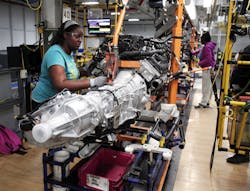Predictive Maintenance: Two Hydraulic Sample Points That Really Matter
Bottom line: simply taking an oil sample from the hydraulic tank is a waste of your oil analysis dollars.
Of course it seems easier to take oil samples directly from a hydraulic tank, but from a predictive maintenance perspective, it turns out doing so offers very little benefit.
While these oil samples can certainly be used to establish the cleanliness of the fluid and the overall condition of its base oil and additives, with the hydraulic system's return filter eliminates any predictive intelligence that could be gleamed from that sample.
Rather, fluid taken immediately upstream of the return filter can still be used to establish the cleanliness level of the fluid, and the condition of its base oil and additives, PLUS it can also provide valuable insight to the condition of the components in the system.
In predictive maintenance language, the oil sample point located immediately upstream of the return filter is called the primary sample location. This means all routine samples are taken from this point (with the system running and at operating temperature). If the primary oil sample shows elevated levels of wear metals, then the task is to establish which component in the system is making the metal. This is so its change-out can be planned-and hopefully executed, prior to in-service failure. To do this, secondary oil sample points are required.
The location of secondary oil sample points in a hydraulic system depends on the type and location of its major components. An obvious location for a secondary sample point would be immediately downstream of the pump. In this case, if the primary oil sample showed a wear metal problem, a secondary sample could then be taken downstream of the pump to establish if it is the responsible component. Obviously, a large hydraulic system can have several secondary sample points located downstream of major components, for use as and when necessary.
Read more about hydraulic sample techniques at Hydraulics and Pneumatics.
Hydraulics and Pneumatics is an NED companion site within Penton's Manufacturing & Supply Chain Group.
While these oil samples can certainly be used to establish the cleanliness of the fluid and the overall condition of its base oil and additives, with the hydraulic system's return filter eliminates any predictive intelligence that could be gleamed from that sample.
Rather, fluid taken immediately upstream of the return filter can still be used to establish the cleanliness level of the fluid, and the condition of its base oil and additives, PLUS it can also provide valuable insight to the condition of the components in the system.
In predictive maintenance language, the oil sample point located immediately upstream of the return filter is called the primary sample location. This means all routine samples are taken from this point (with the system running and at operating temperature). If the primary oil sample shows elevated levels of wear metals, then the task is to establish which component in the system is making the metal. This is so its change-out can be planned-and hopefully executed, prior to in-service failure. To do this, secondary oil sample points are required.
The location of secondary oil sample points in a hydraulic system depends on the type and location of its major components. An obvious location for a secondary sample point would be immediately downstream of the pump. In this case, if the primary oil sample showed a wear metal problem, a secondary sample could then be taken downstream of the pump to establish if it is the responsible component. Obviously, a large hydraulic system can have several secondary sample points located downstream of major components, for use as and when necessary.
Read more about hydraulic sample techniques at Hydraulics and Pneumatics.
Hydraulics and Pneumatics is an NED companion site within Penton's Manufacturing & Supply Chain Group.
